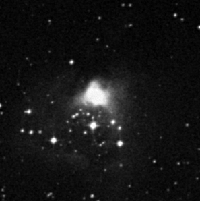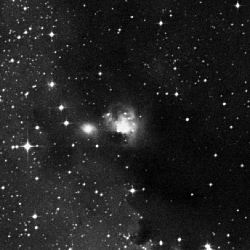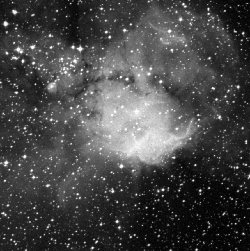From my recent diary
2014
Sunday, December 28
The sky was
clear and I was satisfied with todayfs session. I comet hunted last on
Wednesday, December 3, and more than three weeks have passed since
then. Actually, I tried to conduct a searching session on Wednesday,
December 24, but as soon as I had set up my comet-seeker thin clouds
covered all the sky. I stayed the site until the daybreak but in vain
and went backed home. Since then have I waited for clear sky and
finally the time has come: todayfs session was special since I
introduced new gadgets for the first time.
Introduction of new devices
This predawn I employed two new devices. I believe those make my comet hunting activities more enjoyable.
One was Nexus DSC (Digital Setting Circle), an Australian made high performance device (http://www.astrodevices.com/products/NexusDSC/index.html),
and another was iPad mini 2. As for a DSC I have used Lumicon NGC Sky
Vector and its Japanese version (Navigator, Kokudai Kohki http://www.kkohki.com/English/kkohkiparts.html
). The old DSCs function very well still now, but Nexus DSC features
various kinds of functions including WiFi to smartphones and tablets.
Upon upgrading to the new DSC there was no need to replace the old
encoders installed on my comet-seeker, instead I merely changed a DSC
from NGC Sky Vector (or Navigator) to Nexus DSC, though I fabricated an
attachment to set Nexus DSC to the secondary cage of the telescope.
I installed a
planetarium software, SkySafari 4 Pro, in iPad mini 2 that receive WiFi
from Nexus DSC and the position of my come-seeker is indicated on the
display. How exciting it is to check where the telescope is trained on
the display!

Nexus DSC has
internal rechargeable battery. The battery residual capacity reduced to
87% from full charge after two hours of operation under the air
temperature of -7 ˚C. I think the battery has enough practical
capacity. Three ways of recharge cables are available: AC, car cigar
lighter and USB. Note AC adapters for international use.
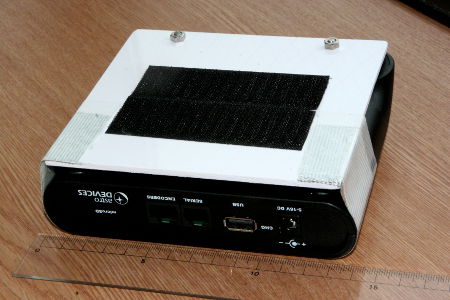
I made an
attachment so that Nexus DSC can be attached on to the telescope tube
using Velcro (black colored). The white plate made of a 3 mm-thick PVC.
Todayfs session
I set Ethos 21
mm eyepiece on the drawtube (97x, FOV=1 degree) and I aimed my
comet-seeker at M104 using SkySafri 4 Pro with Nexus DSC. I tapped M104
on the display (SkySafari) and then tapped eGoTof. Nexus DSC indicated
the angular distances (horizontal and vertical) to M104 just like NGC
Sky Vector does and I moved my comet-seeker so that the both values
became to be zeros. The same thing can be done using Nexus DSC only,
but it was easy and comfortable to use those devices in tandem. Through
those processes, I started todayfs session from M104.
Having said
that, I have wasted a certain amount of time during the session as I
was not familiar with those devices; I overlooked many galaxies that
would have been identified if I had been calm as usual. I often checked
DSOs that came into the FOV by using the iPad mini, but I saw that it
is not effective to look at the display (SkySafari) too often. I
decided to use mainly Nexus DSC (identifying function) to identify
comet-like objects as I have done as before, and I utilize iPad mini
when multiple objects, i.e. galaxy group, come into the FOV. An example
of such a galaxy group is shown as a screen shot of iPad mini
(SkySafari) and an image of DSS.
I spotted 32
galaxies during the session and covered 40x30 square degrees
(vertically and horizontally) during two hours. Todayfs weather was
very severe: besides the 2 m of snow depth, air temperature was -7 ˚C
with weak wind that made sensible temperature lower, but I was happy
with the new devices.
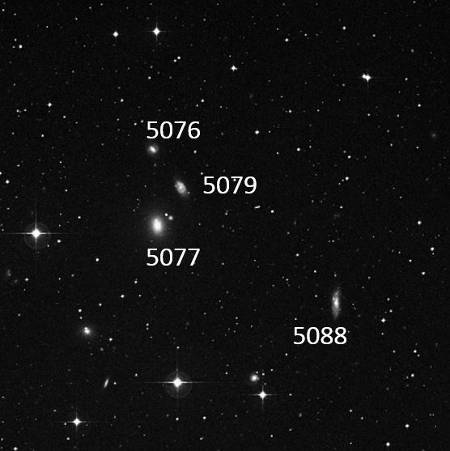
DSS image of NGC5076 (magnitude of 13.1), 5077 (11.4), 5079 (12.0) and
5088 (12.6) that corresponds to the screenshot below. Note that the
south is up and the field is 30f.
The Digitized Sky Survey copyright © 1994

Screen shot of
SkySafari 4 Pro shown on iPad mini 2. The horizon is up and a circle is
1 degree in diameter that indicates the FOV of my comet-seeker with
Ethos 21 mm eyepiece.
Wednesday, December 3
It is unusual that we have clear sky two consecutive days at predawn in December;
I could comet hunt yesterday and today. I have purchased Ethos 21 mm eyepiece from
a US dealer that makes a magnification of 100 with an actual FOV of 1.0 degree
combining with my 46 comet-seeker, and I used it for the first time yesterday.
The difference of magnification between 78x (Planocular 30 mm 88 degrees +
Paracorr) and 100x (Ethos 21 mm 100 degrees) is significant. The background in
the FOV got darker due to higher magnification that makes searching activity
effective, not to mention the super wide field. I felt it was very comfortable
to use this eyepiece. As I wrote the other day, I could notice darker galaxies
easily than using 78x. On top of that, it reveals detail structures of galaxy
and I enjoyed looking at it. However, I could search only 15 degrees per hour
horizontally (with 40 degrees vertically) comparing some 17 degrees per hour
with 78x and 20 degrees with 68x (Pulanocular 30 mm without Paracorr). Even so,
Ethos 21 mm makes my comet hunting session attractive and I think I will
continue to using this eyepiece from now on.
Letfs get back to todayfs story. I got up at 2:30a.m. and the sky was clear. Five
minutes after arriving at the observing site could began covering the sky. I hesitated
to set up my comet-seeker because not only of increase in the amount of cloud
but also of lightning with a clap of thunder that generated far away. I checked
a radar image using a mobile phone and I confirmed there was no rain cloud near
the site. I waited for the clear sky patiently for about half an hour, and
finally I decided to set up the comet-seeker at 3:30a.m. since cloud began to
disappear.
I began sweeping the sky from alpha Corvi. Clouds covered the search area many
times, but I identified 12 DSOs in total including 13th magnitude galaxies:
NGC3791 and 3866. I used 15x110 mm binocular from 4:50 to 5:08a.m., i.e. before
the beginning of the twilight, that swept the area of some 30 degrees x 60
degrees (vertically x horizontally). I identified M5 and M104 with the
binocular.
Employing super wide field optics, i.e. Ethos 21 mm for 46 cm Newtonian and
15x110 mm binocular with 6 degrees FOV, made the hunting session more enjoyable
than ever.
Friday, November 21
Unexpectedly and luckily, we had many fine days in November, and I conducted
comet hunting session six times so far in this month. On top of that, the
transparency was the highest at this predawn throughout this autumn, though the
wind was strong and seeing was moderate.
I began to sweep the sky from M104 at 3:55a.m. I identified 23 galaxies during
the session. The most impressive object was NGC3852 galaxy group between the
boundary of Leo and Virgo. I noticed three of them, NGC3852 (a magnitude of
12.8), 3848 (12.8) and 3817 (13.3) but the two stars I saw near the group were
actually not stars but galaxies: NGC3819 (14.0) and 3820 (14.5). I noticed the
fact at home in the evening when I checked them using a digital star map. The
apparent diameter of those two galaxies were less than 1 arc minute and I could
not recognize them as galaxies but as stars.
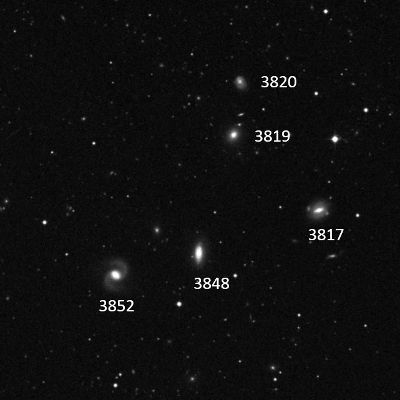
NGC3852 galaxy group (I do not know if this is the formal name). The field is 15
arc minutes.
The Digitized Sky Survey copyright © 1994
The apparent size of comet-like object is one of the major factors to notice it
during the session. I used to omit many planetary nebulae because of the small
size; I took them for stars. However, this is the first time I noticed that I
mistook galaxies for stars. The other factor if one can identify comet-like
object or not is, off course, the magnitude. I used the magnification of 68
when I discovered C/2002 E2 Snyder-Murakami, while I did 78 at the discovery of
P/2010 V1 Ikeya-Murakami. I have never ever noticed Stefanfs Quintet with the
magnification of 68 but I could recognized the group many times with the
magnifying power of 78. Generally speaking, the higher the magnification is,
the higher the chance of discovering faint comet becomes, if seeing is good.
However, the area of the sky one can sweep decrease with increasing the
magnification and note that the maximum magnification exists; in my impression it
is three to four times of the aperture in centimeter for comets.
For this reason, I thought it is ideal to use both a large aperture telescope
with high magnification and a small aperture telescope with low magnification
in tandem. I bought a 15x110 mm binocular for this purpose and actually I spotted
a possible new comet in 2004. I did not employed the binocular for a while but
I used for 15 minutes at this predawn from 4:55a.m., five minutes before the
beginning of the twilight. Beautiful thin crescent moon decorated by an
earthlight passed through the FOV. At the dark night with high transparency I
want to set up and sweep the eastern sky using this exquisite Russian binocular
from now on. A new bright comet may appear at a low altitude like that of 2004
again.
I got back to the 46cm-comet-seeker with 78x again at 5:10a.m. and completed
the session at 5:30a.m.
Thursday, October 30
There were many fine days during the latter half of October, and today was the
6th comet hunting session including October 18, the day of the first session in
the month. I have continued the searching session every clear sky in spite of having
been busy at work, and I have got ill for a while. Now I have almost recovered
(on Nov. 3).
I trained my telescope at C/2014 R1 Borisov before the start of the session but
I could not observe the comet probably due to the low altitude.
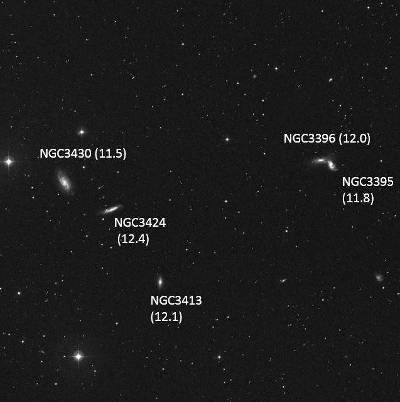
NGC3395, 3396, 3413, 3424 and 3430. Figures in the parentheses are the
magnitudes. The field is 45f.
The
Digitized Sky Survey copyright © 1994
On Saturday October 18, I swept the sky from Sirius, and I spread the search
area northward session by session. Today, as a series of search since last time,
October 26, I swept eobservation window of the universef in the constellations
of Coma Berenices and Virgo. I began to search from M100 near where I finished
the session last time. I introduced the galaxy using the digital setting
circles but I could not see M100 even with 46 cm comet-seeker because of the
low altitude of only 7 degrees. I aimed my comet-seeker at an altitude of around
40 degrees, and I moved it toward the horizon. Soon after the start of the
motion, a pair of galaxies, NGC3504 (magnitude of 10.9) and 3512 (12.3) in the
constellation of Leo Minor came into the FOV. In addition to bright zodiacal
light, unsatisfactory air transparency dictated the limiting magnitude of
galaxy to 12th magnitude; I could not identified the galaxy with the13th
magnitude. After that I identified some other galaxies and then five galaxies
with magnitude of 11th to 12th came across in the same FOV: NGC3395, 3396, 3413,
3424 and 3430. NGC3395, and 3396 are interacting galaxies. They were at an
altitude of 35 degrees and the background was dark enough that made me feel
they were floating on the universe and impressive.
In case that there were many galaxies in the same FOV, firstly, I identify one
of them using the digital setting circles. Secondly, I look at the galaxy image
using eDeep Sky Browserf, an appli of the iPod. The field size of the image is
set at 1 degree or 30f and I compare the arrangement of the galaxies in the
image with that in the FOV to identify the other galaxies. I used to turn the
pages in the Uranometoria 2000 to check the galaxies but iPod is more
effective.
C.f. Diary on Nov. 2, 2011
http://homepage3.nifty.com/cometsm/diary/2011-diary.html
Deep Sky Browser
http://www.astrodevices.com/products/DSSBrowser/index.html
I identified and enjoyed showpieces in the constellation of Coma Berenices, M64
(Black Eye Galaxy), M54 (globular cluster) and NGC4565 (edge on galaxy). They
all were at the low altitude but it was easy to observe eBlack Eyef in M64, to
resolve M54 into stars and to see clear dark lane in NGC4564. Air temperature dropped
down to 2 degrees Celsius but I did not feel very cold.
I observed 26 galaxies and one globular cluster and completed the searching
session at 5:10a.m., 30 minutes after the beginning of the twilight.
Saturday, October 18
I comet hunted for the first time at this predawn, as my workload has been
heavy and the weather was unstable for those three weeks. It took longer time
to set up my comet-seeker with my winter clothes, since cold suddenly set in.
Air temperature dropped to 4 degrees Celsius.
Jupiter, the king of planet, and beautiful white moon led the constellation of
Leo that rose on the eastern sky. Leo looked more majestic and stronger with
Jupiter and the moon. Hydra rose with its long body and on the sky with Leo
side by side.
Prior to the hunting session I observed C/2012 K1 PanSTARRS at 2:20a.m. The
magnitude was 7th, with a diameter of 5f and DC was 4 by intuition, but it was
not precise observation using reference stars. The tail was not observed due to
moonlight.

Leo led by Jupiter and the moon.
I aimed my telescope at Sirius where I started the searching session. Even under
the moonlight the Milky Way around Monoceros and Puppis was lovely and some unexpected
DSOs were came across the FOV. The first one was NGC2316, a reflection nebula,
which was nebulous and has only 0.3f of apparent diameter due to moonlight. I
cloud manage to notice this object because it passed through near the center of
the field. The next object was NGC2327 that looked like a star at a glance but it
was surrounded by dim nebulous light. I myself felt that I could notice this
challenging object. This nebula is the head part of Seagull Nebula. The third
one was "Skull and Crossbones nebula", a combination of NGC2467and Sh2-311.
This one has a large apparent diameter and I will never overlook as far as the
sky condition is good. I think I identified this object in the past. NGC2438, a
planetary nebula in M46m, looked bright and large. C/2012 K1 did not come into
the FOV during the session as the cloud passed the search area at the low altitude.
From the left to right: NGC2316, the image is 5f wide, NGC2327, 10f, NGC2467,
15f.
At 4:30a.m. clouds covered in the southern and the eastern sky. I trained my
comet-seeker at Ursa Major. I identified M51, NGC3898 and 3998 and completed
the session.
Tuesday, September 23
The clear sky woke me up at 1:10a.m. JST, 30 minutes before the alarm clock
rang. I experienced such a wake-up many times. I think my body sensor can
detect changes in temperature and/or air pressure and lets me know the timing
of wake-up. I have ever woken up suddenly, regardless of not setting the alarm
clock; I did not set the alarm as I expected it would be cloudy at predawn. It
happened the day when I discovered C/2002 E2 Snyder-Murakami. This predawn I got
up at 1:30a.m., 20 minutes after my first wake-up as I wanted to stay a bit
longer in my bed.
I comet-hunted on Sunday, September 21 under the clear sky, but it was not dark
night as the crescent moon was shining. On Sunday, I could identify no comet
like objects but I encountered C/2012 K1 PanSTARRS. Earlier than September 21,
I swept the sky on Wednesday, September 3 and Thursday, September 4. On Sep. 3
seeing was extremely bad and stars swelled in the FOV with a lot of clouds. On
Sep. 4, I was irritated by strong wind with frequent passage of clouds through
my search area. This predawn it was cloudless and windless, and, I expected I
would make an intense hunting session.

NGC2683, very elongated one in Lynx. The field is 15f wide.
The Digitized Sky
Survey copyright © 1994
At 2:30a.m. I aimed my telescope at Pollux, Beta Geminorum, and started the
session from this star. In a short time, Jupiter passed through the FOV and
then Castor, a double star, did. I detected NGC2903, a galaxy in the
constellation of Leo, with an altitude of 10 degrees above the horizon. The next
galaxy that came into the FOV was NGC2683, very elongated one in Lynx followed
by NGC2964-2968, a pair of galaxies, NGC2859, 3245, and 3021. The darkest one
among those is NGC3021 with a magnitude of 12.2 referring to Guide 9, a digital
map. However, I did not notice NGC3003, a magnitude of 11.5, which is seen in
the same FOV with NGC3021. In my impression NGC2968 (magnitude of 11.7) was the
faintest among those. The darkest galaxy in terms of the total magnitude is
NGC3021, but the surface brightness of this galaxy is high with small apparent size.
I took a break and looked up the sky. Dignified and valiant figure of Orion,
Leofs powerful upper half of the body that was about to rise above the horizon,
elegant flow of the autumn and winter Milky Way and zodiacal light that was
like a ray released from Leo; all were splendid form of the universe. Happiness
that I could hear peaceful music played by insects in this gorgeous cosmic hall.
In the past when there was no light pollution, everyone could enjoy such a
wonder.
After completing the two hours of the session, I began to see the real world
with the daybreak. The thin moon rose when I tool down my comet-seeker.
Saturday, August 30
It has been cloudy and rainy throughout August, and there occurred many
flooding all over Japan. In my impression inundation hit at least one city
every week. Obviously, the weather pattern is abnormal.
The number of times I comet hunted in August was only twice: Friday 1 and Saturday
2. Since then, I got up at predawn several times but every time it was cloudy. While
we have cloudy and rainy weather, two comets that are expected to be bright
were discovered. One is C/2014 Q1 PanSTARRS and another is C/204 Q2 Lovejoy.
The magnitude at the time of discovery was 18.4 and 14.8, respectively. Both of
them were not within reach of my comet-seeker, even if I take the fact that the
brightness measured by CCD into consideration; CCD magnitude is darker than
that of visual one by about two, though the reason of this difference is
unknown.
C/2014 Q1 PanSTARRS may be seen by naked eyes in the next summer, while C2014
Q2 Lovejoy will reach 8th magnitude in January. No comet has been discovered
visually since P/2010 V1 Ikeya-Murakami, but I believe visual discovery is
still possible. I will wait for the clear sky patiently.
Saturday, August 2
Again, the forecast was completely off and the clear sky have
prevailed since
last dusk. I was preparing for todayfs session since last dusk. I went
to bed at 8:50p.m. on Friday, and got up at 1a.m. this predawn. I drove
to one of
the usual observing sites. At the site the transparency was pretty
good. The Milky Way
was very impressive near the zenith. However, wind was very strong due
to a
typhoon and I set up my telescope near the lee side of a building to
avoid wind
force applied on the optical tube assembly.
I aimed my telescope at NGC596 that was the last galaxy I identified yesterday
from where I started the session. It was very comfortable to sweep the sky,
since dark back ground made shining of stars brighter and clearer; the transparency
last month was poor and the back ground was not very dark yesterday due to
light pollution. Once I pulled down my comet-seeker to the horizon, then I moved
it up to the altitude of some 40 degrees from where I sweep the sky toward the
horizon again. While I was moving my telescope upward, it took only several
seconds, I sometimes looked at the sky instead of FOV; during the motion of only several
seconds I accidently saw a bright satellite flash! It was brighter than -3
magnitude at 2:38a.m. At home it turned out to be Iridium 57 with the magnitude of
-4.
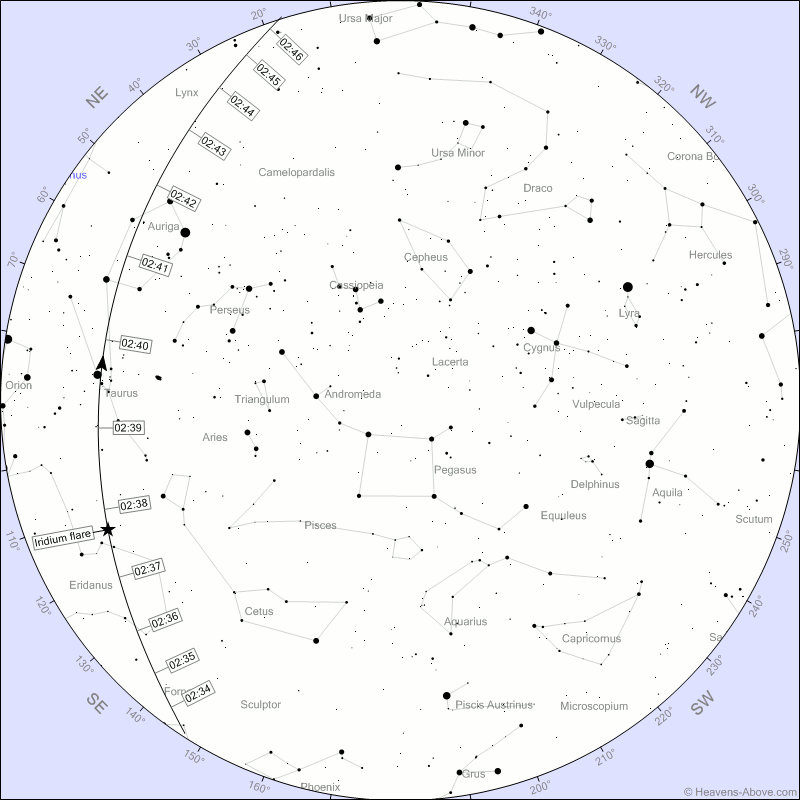
Flash by Iridium 57 that I accidently witnessed. Click to enlarge.
Many galaxies came into the FOV and some of them were 12th magnitude. As a
result I identified 17 galaxies and swept 34 degrees horizontally during one
hour and 40 minutes. Though some clouds passed through the search area, it
really was enjoyable and satisfying session.
Friday, August 1
The weather forecast was completely off the mark. It was rainy last dusk and I was
unprepared to comet hunt. However, it seemed that my body sensor detected the
clear sky and I suddenly woke up at 2:05a.m. when just one hour before the
start of the twilight. I was in a hurry to go comet hunting. The observing site
should be the nearest one: a farm land behind my residence.
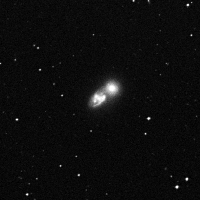
Interactive galaxy, NGC274 (left) and 275. The image is 10f wide.
The Digitized Sky
Survey copyright © 1994
I set up my comet-seeker as soon as possible and began to search the sky at
2:40a.m. from Deneb Kitos, Beta Ceti. I identified 8 galaxies during one hour
and five minutes of the session: NGC157, 210, 274, 275, 337, 613, 584 and 596.
NGC274 and 275 are interacting galaxy and it was easy to separate using my 46
cm comet-seeker with x78. Today I was happy to conduct the session
unexpectedly.
Monday, July 21 (National holiday)
It had been cloudy, and finally, today I could conduct the first comet hunting
session this month. The last one was Saturday, June 28.
At Sunday night the forecast predicted a cloudy sky throughout the night, and I was unprepared.
I looked up the sky and noticed it was cloudless at 9p.m. JST. The forecast was
off, and I went to bed as soon as possible. As a result, it was 10p.m. when I hit
the hay on Sunday.
I got up at 1:50a.m. and set up my
comet-seeker at a farm next to my residence. I trained my comet-seeker at Deneb
Kaitos, Beta Ceti, and started the session from there. Thanks to excellent
seeing, stars gave off innocent light that I felt like my mind was being drawn
into. The place where stars are shining is where we are from and where we will
go in the future. At 3:15a.m. cloud began to cover most part of the sky, and I
aimed my telescope in the north-east where there was a gap among clouds. I
completed the session in 10 minutes since then.
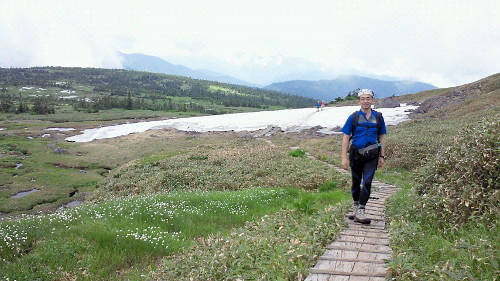
I was walking on the wood plate along a cotton grass (Eriophorum vaginatum) colony. You
see snowpack in the background of the photo.
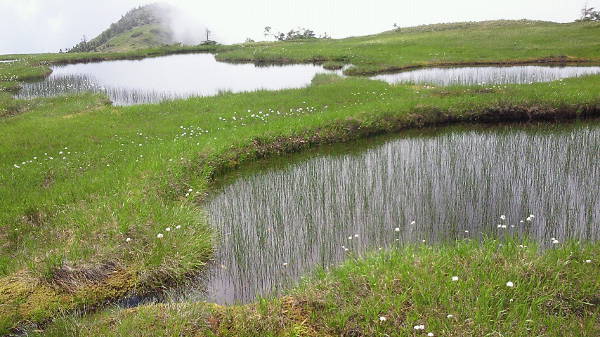
Bogs at the plateau near the top of the mountain.
After one and half hour of sleep, I headed for Mt. Naeba, 2145 m above sea
level (a.s.l.), for mountaineering. I am not sure when I visited this mountain
last, but I climbed it at least five times. After one hour drive from my house,
my wife and I arrived at the parking lot with an altitude of 1310 m where we started
to climb. Three hoursf walk brought us to the plateau, 2000 m a.s.l. from where
beautiful wetland extending.
Today, we enjoyed great natural beauty and I was satisfied with the mountaineering
in addition to the hinting session.
Saturday, June 28
There were two big cometary news this
month. One is a passing away of Bill Bradfield, the great Australian comet
hunter. Another is a detection of 72P Denning –Fujikawa by Hidetaka Sato. The
comet was discovered by Denning in 1881 but had been missed until 1978 when Shigehisa
Fujikawa re-discovered it. After Fujikawafs re-discovery the comet has been missed
again. I am glad 72P was detected by Japanese observer.
The sky of this month had been cloudy at
night while it was fine in some days only in daytime. I waited for clear sky
and as a result I could conduct the second comet searching session at this
predawn.
The first one was on Thursday, June 26, but the session was not satisfactory. On
Thursday I drove to the new observing site where I made a preliminary inspection
in daytime several days ago. I started the session at 1:35a.m. local time (JST)
as the twilight began at 2:34. The site looked good at first. However, at 2a.m.
dense fog was formed and grew quickly from Shinano-gawa River that is the
longest river in Japan and flows through my city. The river is the major source
of water vapor. Fog covered some 20 degrees above the eastern horizon and I
could not search the eastern sky. I trained my comet-seeker to the north and
identified NGC 3945, 5832 and 4605 during the session. At 2:55a.m. I got back
to the eastern sky as fog disappeared and enjoyed observing C/2013 UQ4 Catalina
for the first time. C/2013 UQ4 was bright, 10th magnitude with a bright
nucleus.
I will never visit this observing site again. I read somewhere that Minoru
Honda used about 20 observing sites. I also counted the number of the sites I
used; it was over 20.
Today I greatly enjoyed the second hunting session this month. I went to one of
the usual observing sites. I wanted to search the east but the eastern sky was covered
with cloud. I aimed my comet-seeker at Mirphac, Alpha Percei, where there was
no cloud, and began with the session there. Wind was strong and I felt it
annoying but the sky was clear and seeing was rather good. Though I did not encounter
any comet like objects, I was impressed by the beauty of the star field. There
are many open clusters along the area I swept, in the constellation of
Cassiopeia and Perceus. I was satisfied with the loveliness of these clusters. On
top of that I took off during the session to observe M31 and M13 for a few
minutes. The dark lanes in M31 were very clearly seen and I noticed some HII
regions. M13 was jaw-dropping.
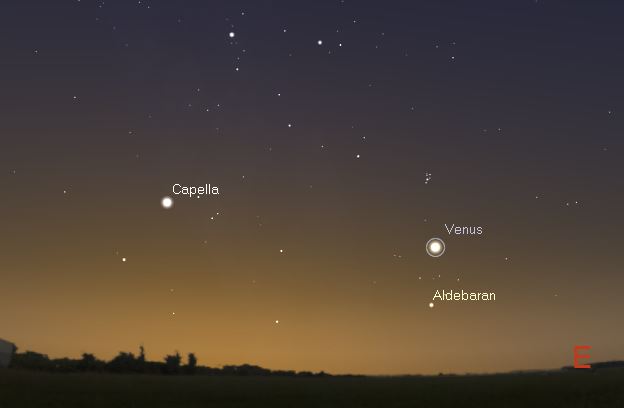
Image was produced using Stellarium
During the twilight Capella, Venus and Pleiades were above the eastern horizon.
Before the time when I completed the session Seven Sisters were fading gradually
and disappeared in the sunrise colors. Lovely daybreak.
Sunday, June 1
The
total number of comet hunting sessions in May was 8, though there were much
more days with clear pre-dawn. For example, it has been clear sky at pre-dawn
for 5 consecutive days since Wednesday May 28, but I comet searched only on
Wednesday and Thursday. The reason of less searching days was poor atmospheric
transparency.
As I wrote on the last diary the concentration of PM2.5 correlates with
transparency, but I experienced excellent transparency with PM2.5 of > 20 Êg/m3
that meant atmospheric transparency is not dictated by PM2.5 alone. I assume
humidity may plays an important role on transparency in addition to yellow sand
from the continent. I stop searching for three days, Friday May 30 to today,
due to yellow sand from Chinese desert. This nasty condition will last at least
a few more days.
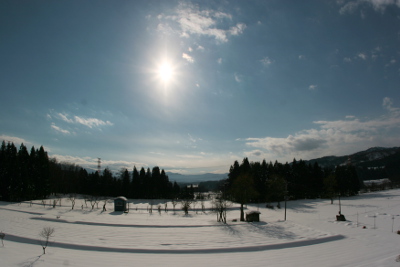
|
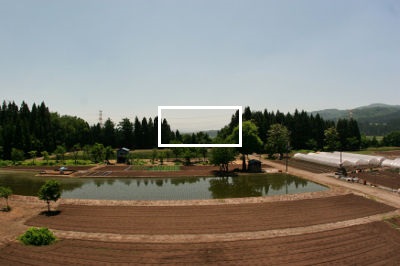
|
Photo taken on December 30, 2013 with excellent atmospheric transparency (left),
and June 1, 2014 with poor transparency because of yellow sand originated in
Chinese desert (right). The mountain range 30 km away was not visible on the
photo of June 1 (shown by a square on the left photo).
The most impressive session in May was that on Thursday, May 8. The sky was so
clear that I was attracted by the summer Milky Way as search area, although it was
at the meridian. I identified some 30 DSOs in the Milky Way. They included NGC6541,
a 6th magnitude globular cluster in the constellation of Corona Australis. When
I identified it I wondered if I have ever observed this cluster as the altitude
of the cluster was only 9 degrees at the time of transit. Another impressive
object was Barnard 289, a dark nebula, in Sagittarius. The contrast of dark nebula
and the star ground with complicated structure was very clear.
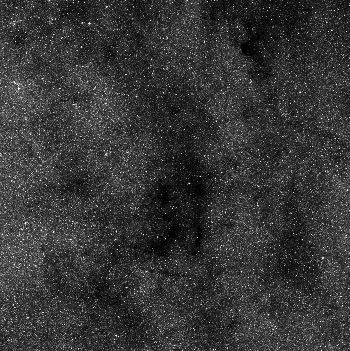
Barnard 289. The image is 1 degree wide.
The Digitized Sky
Survey copyright © 1994
I hope the recovery of air transparency before the start of rainy season that
usually start early or middle of this month in my city.
Sunday, May 4
Atmospheric transparency
This is the second comet searching session
in May. At the first session on Thursday May 1, I was satisfied with the excellent
air transparency when I arrived at the site. Nevertheless, it was degraded to
the moderate level with time during the session.
Yesterday, I got up at 1:15a.m. and drove to the observing site, however, contrary
to the sky condition on Thursday, it was poor. I must give up conducting a
comet hunting session; I got back home from the site at once without setting up
my comet-seeker.
Today the atmospheric transparency was not bad but less than average especially
near the horizon.
The haze that influences the transparency mostly
originates from the continent. Specifically, yellow sand and other aerosols are
the cause for poor transparency. I knew there exists a forecast for yellow sand
http://www.jma.go.jp/jp/kosafcst/
, but I had no idea what kinds of aerosols other than yellow sand affect the
atmospheric transparency. Recently, media publicizes that particulate matter
2.5 (PM 2.5) affects public health and that China releases a lot of PM2.5,
though the fact has been known and the measurements of this material has been
conducted since more than a decade ago. I must say the government tries to hide
health problems caused by radioactive materials from Fukushima using such an announcement.
Anyway, I have internet searched for the first time on the forecast of PM2.5 and
spotted sites: http://sprintars.riam.kyushu-u.ac.jp/forecast2.html http://pm25.jp/
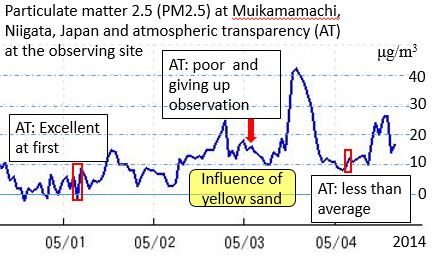
Changes in PM2.5 at Muikamachi 22 km ESE from the observing site.
http://soramame.taiki.go.jp/DataList.php?MstCode=15463010
Here is data on PM2.5 that corresponds to what I have
experienced about the air transparency. On Thursday May 1 the transparency was
excellent with the concentration of PM2.5 of 2 Êg/m3 at 3a.m. but it rose up to 6 Êg/m3 at 4a.m. At dawn on Saturday May 3 the values were
large, 18 and 15 Êg/m3,
at 1a.m. and 2a.m., respectively, and I went back home from the site before
2a.m. Today PM2.5 was around 10Êg/m3 and the transparency was a bit less than average. Among
those three days the contribution of yellow sand was obvious only on Saturday May
3. Overall the transparency seems to change with the concentration of PM2.5.
I am sure atmospheric transparency is governed at least by the concentration of
yellow sand and MP2.5, though air contains various kinds of aerosols for which
the forecasts are released from the abovementioned web site. From now on I will
check out not only the forecast of yellow sand but also that of PM2.5 prior to
the comet hunting session. I wondered if this kind of air pollution was so
serious in my boyhood.
Letfs get back to todayfs story. During the twilight at 3:14a.m. I saw a bright
satellite of the first magnitude was heading for the eastern horizon in the
constellation of Pegasus. I presumed that it must be International Space
Station. But it turned out to be the Chinese satellite gTiangong 1h when I
investigated on it at home http://www.heavens-above.com/
. Everything changes with the time.
Saturday, April 26
I have comet hunted four consecutive days
at predawn since Wednesday. At the center of my city snow disappeared two weeks
ago, and the climate is comfortable with full of flowers everywhere in the city.
Now, many people feel it is the best season of the year.

Fukino-tou (Petasites japonicas, yellow
flower), remaining snow and cherry blossoms around my office.
Unfortunately, though the crescent moon remained in the east at predawn, I
enjoyed satisfactorily hunting session except on Saturday; the sky was hazy due
to PM2.5 (particulate matter 2.5 from the continent). On Saturday, however, I
took some photos. In spite of the poor transparency, the summer Milky Way is
clear on the photos. Please note that the light pollution on the lower left
where I stood, which was originated from Yuzawa-town with a population of only 8,300
(Photo 1, Figure 1).
 Click to enlarge
Click to enlarge
Photo 1. Comet hunting session under the summer Milky Way.
Image was processed
by MS-Photo Gallery. Canon 20Da, EF15 mm F2.8 (F2.8), 30 sec. ISO1600. April 26
2:24. 2014 (JST).

Figure
1. Light source around the observing site (from the diary on June 8,
2013).
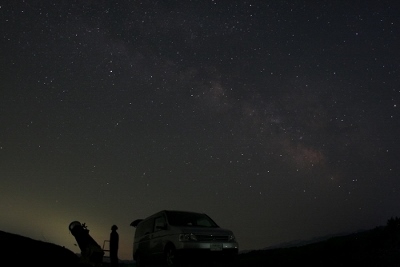
|
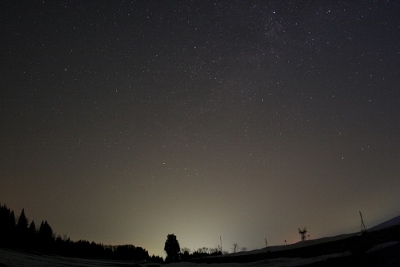
|
|
Photo 2. Light pollution caused by Yuzawa-town, 18 km from the site
(lower left). The same photo with Photo 1, but non-image processed. |
Photo 3. Light pollution originated from Tohkamachi-city,
18 km from the site. The same photographing conditions with Photo 1. April 26
2:35. 2014 (JST). |
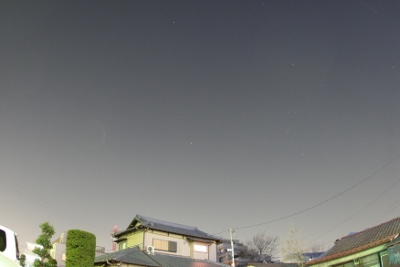
Photo 4. Light pollution at Toda-city,
Saitama, 18 km NW of the central part of Tokyo. Except for the exposure time (1
sec) and the date, photographic conditions were the same with Photos 1 to 3.
March 28 19:34 2014 (JST).
Photos 1 and 2 are the same but Photo 2 was not image processed. Photo 1 to 3 were
taken at the same site at the same predawn. Photo 3 was taken toward the center of Tohkamachi-city
where a population of 57,600. One can see the degree of light pollution for
Yuzawa and Tohkamachi on Photos 2 and 3, respectively. I myself was disappointed at the
seriousness of the light pollution caused by such small town or city to see the photos.
However, Photo 4, a shot near Tokyo, is more serious. The exposure was one second
under the moonless condition but the sky is very bright. You can see Sirius at
the center and Betelgeuse on the upper right.
Thank goodness I live under the dark sky.
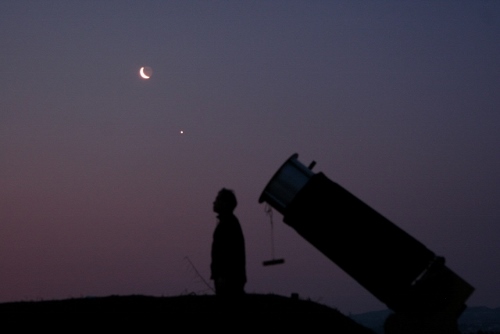
Photo 5. Moon, Venus and me. EF24-105 mm F4
(F4), 1 sec. April 26 4:15 2014 (JST).
Saturday, March 12
Luckily, I have conducted the sixth comet searching session this month at
predawn today. When I set up my comet-seeker before 3a.m., the gibbous moon was
still above the horizon. I enjoyed observing Mars that is at opposition on
March 14 and Saturn before the start of the session, though seeing was less
than moderate. On Mars Syrtis Major was apparent at a glance with a magnification
of 290 but I wondered why the southern polar cap was seen instead of the northern
one. I peered at the disk carefully again and I noticed a small northern polar
cap while the white part in the south was not the southern polar cap but it
looked white anyway. I checked the white part when I got back home and it
turned out to be Hellas. The other conspicuous feature on Mars was bluish-white
cloud on the east edge. Cassini's Division on Saturnfs ring was clear through
round the ring, but the other features on the ring, e.g. C ring and Encke Gap, were
not seen.

Mars. April 12, 2013 at 3:00 JST
Sotuh is up.@(c)@Guide 9.0
At 3:05a.m. the sky was getting darker as the moon declined and I
began hunting from Antares. I encountered more than a dozen of globular
clusters but the only exception was a planetary nebula in the
constellation of Scorpius,
NGC6153. It has an apparent diameter of only 0.4f but I could
distinguish it
from a star. If the seeing had been above the average it would be easy
to detect it, but
I could manage to do due to low altitude of the object, 13 degrees
above horizon,
and poor seeing.
At 3:20a.m. I noticed the battery of the digital setting circles died when an object
that looked like a globular cluster came into the FOV. It was near the
tail of Scorpius and it was easy to train my comet-seeker at the object again after changing
the buttery and reset of the digital setting circles. I identified the object
as a globular cluster, NGC6388, using the digital setting circles. However, I
should know better. I had taken a note of the altitude and the azimuth of the
object using the graduations on the circles (see photos below). If clouds had
covered the object rapidly I could not identify the object.
Photos are from the diary on August 9, 2013.
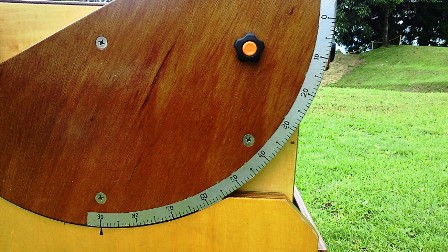
Altitudinal circle
|
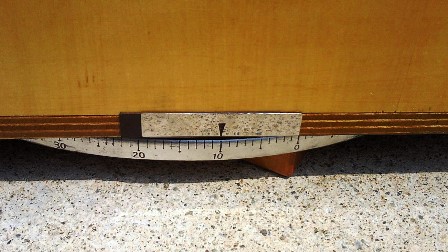
Azimuth circle
|
The sky was dark in a very short period of time,
since the moon set at 3:20a.m. and the twilight began at 3:45a.m. Before 4a.m. the
background in the FOV was getting brighter as twilight proceeded like that
under the moonlight one hour ago. I enjoyed the last hunting session before the
full moon.
Friday, March 28
This is the second comet hunting session in March. As I wrote last diary, I
could not conduct the hunting session on March 4 due to the trip, and I was unable
to do either because of a cold on Monday, March 24. On Tuesday, March 25 I
could manage to conduct the first comet searching session this moth under the crescent
moonlight, but my health condition was not very good.
Today, I almost recovered and the moon was rather
thin. Before the start of the searching session, I observed C/2012 K2 PanSTARRS
for the first time. It was 9th magnitude with d = 3f and tail = 2f by
intuition. Then I trained my comet-seeker at M9, a globular cluster, in the
constellation of Ophiuchus, and started the session from this object, since I
completed the session near this area on Tuesday. I encountered as many as 23
DSOs during the session. Most of them were globular clusters including
showpieces in the summer Milky Way like M20, M8, M22 and M17. NGC6445, a
planetary nebula, and NGC6440, a globular cluster, in Sagittarius were in the
same field of view with an angular distance of 22f. I always notice this pair
when I search the area. I was impressed by the brilliant stars in the Milky
Way.
At the start of the twilight I observed two
more comets. C/2012 X1 LINER was 8th magnitude d = 3f and tail = 2f, while
C/2013 R1 Lovejoy was 11th magnitude d = 1f with tail = 3f. Those two comets
were still bright!
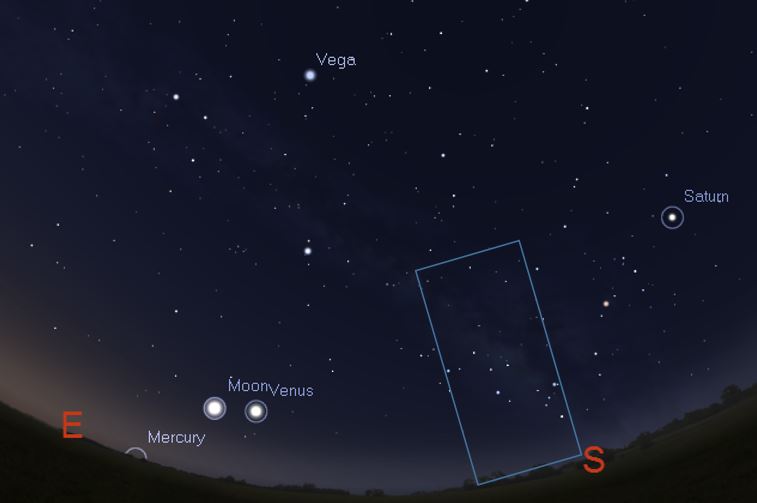
The square shows the area I
swept with 46 cm x71.
I completed the session at 4:45a.m. when
the crescent moon and Venus rose above the horizon.
Tuesday, March 4
It must be a clear sky this predawn but I could not comet hunt. I had been in a
collage in Ishikawa Prefecture to give a scientific presentation as a forest
hydrologist. How unlucky it was! I comet hunted last on February 12 and there
is no prospect I can do it in a coming week.
This winter I went on a skiing many times. It is only 15 minutesf drive to the nearest
ski field from my residence. If I am lucky I can ski along a beautiful beech stand.
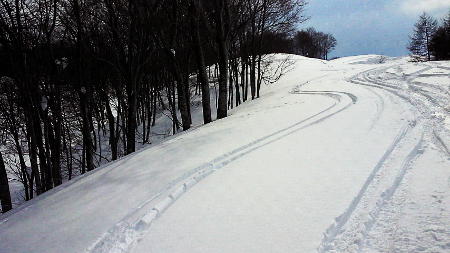
My ski trail (left) along the beech stand.
During my skiing session I spotted a wonderful artwork of snow. We call it
Yuki-Makuri, a rolled-snow if I translate it into English directly. A piece of
snow that falls down from a tree rolls down along a slope and produces such an
interesting shape under a certain condition. The diameter of Yuki-Makuri shown
below was around 50 cm. This one is the finest one I have ever seen.
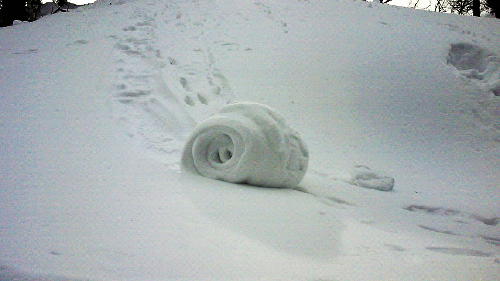 |
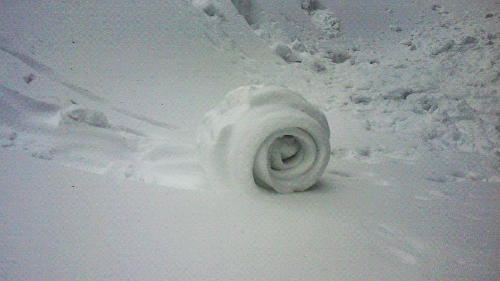
|
Yuki-Makuri, a rolled snow. Some 50 cm in diameter. Those photos are the same
Yuki-Makuri but the angle of the shots were different.
Skiing is a wonderful sport for fitness since one can enjoy not only exercise but
also beauty of winter nature.
Wednesday, February 12
At 3:25a.m. I arrived at the usual observing site. The sky was crystal clear
with a biting cold. Air temperature was -8 degrees Celsius but I felt a sense
of fulfillment as I could have the second searching session in February. At
4a.m. I competed setting up my comet-seeker but I was clouded out. I believed
the clear sky appeared again and waited for a while. At 4:15a.m. stars began to
shine on the southeastern sky and I started comet hinting near alpha Librae.
The first DSO I encountered was NGC5824, a 9th magnitude globular cluster in
Lupus. The next one was NGC5796, 11th magnitude galaxy in Libra, but at the next
moment I notice a companion of the galaxy, NGC5793. The magnitude is 13th and I
could not recognize it without observing NGC5796. The third DSO was a pair of
galaxy in Libra, NGC5898 and 5903. Both of them are 11th magnitude. I was moved
when the showpiece of the constellation of Libra, NGC5897, a globular cluster,
came into the FOV. It looked larger in apparent size as I peered it for a
moment because I could detect fainter stars in the cluster, and the stars in
the cluster were beautifully resolved!
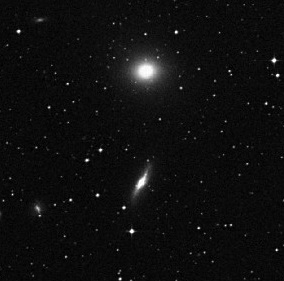
NGC5796 (upper galaxy) and 5793. The image is 8f wide.
The Digitized Sky
Survey copyright © 1994
However, the happy time did not last through the session. At 5a.m. clouds hid
the eastern sky, and I searched on the north and on the northwest seeking the
gaps among clouds. At 5:20a.m., 10 minutes after the beginning of the twilight,
I finished the session and enjoyed observing Saturn through the cloud. The well-opened
ring shined bewitching blue.
Tuesday, January 28
This was the third comet hunting session in January, and it is lucky enough to
conduct the sessions as many as three times at mid-winter here in heavy snowfall
area. The snow depth around the observing site was 180 cm that is norm.
I got up at 3a.m. and drove to the site. The counter grow was visible as I
arrived at the site several minutes before the moonrise. I trained my
comet-seeker at Saturn and started the session from there at 4:05a.m. Soon, the
eastern sky became gray due to moonlight and the crescent moon with beautiful earthlight
rose.
The first DSO I identified was NGC5812, a galaxy in the constellation of Libra.
I could manage to distinguish this galaxy from a star, but if it passed through
near the edge of the FOV it was difficult to do because of poor seeing; star
image was swelled. The other all DSOs I encountered were globular clusters.
While I was sweeping the sky I encountered a beautiful pair of stars: beta
Scorpii, yellow primary and light blue companion. Both stars looked like
dancing due to bad scintillation that made them more attractive.
At the start of the twilight I observed tow comets. C/2013 R1 Lovejoy was still
bright remaining 7th magnitude with a tail of 0.5 degrees long. C/2012 X1
LINEAR was 9th magnitude and the tail length was 0.2 degrees.
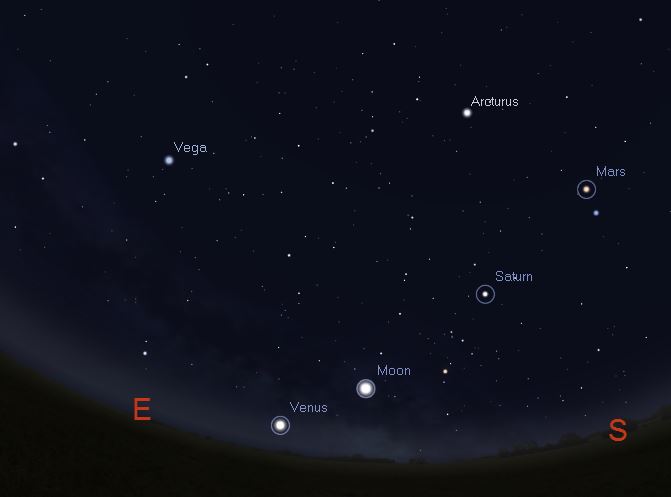
I got back to the session after observing the two comets. The earthlight on the
moon appeared mysterious in the FOV, while Venus was shining ostentatiously, elegantly
and gracefully just above the horizon. I looked up the eastern sky. How gorgeous
it was! Mars, Saturn, Moon, Venus, Spica, Antares, Arcturus, Vega, Altair and Deneb!
Beautiful dawn.
Wednseday, January 1
A happy New Year to you.
This is the first time I stay here in Tohkamachi on January 1 since I
began to
live here nearly 13 years ago. Usually, I went back to my motherfs
house or
travelled somewhere.
The sky was clear this predawn, though the cloud cover increased up to
80% for
a while during the comet hunting session.
Prior to the comet hunting session I observed C/2013 V3 Nevski that has
just
passed the meridian with an altitude of 85 degrees above the horizon.
The comet
was extremely diffused, and one might overlook under the poor sky
conditions.
I stared the session at 4:30a.m. local time, about one hour earlier the
beginning of the twilight. I wanted to begin with the eastern sky, but
the
cloud hid the eastern sky and I was forced to search the southeast.

NGC4783 (upper galaxy) and 4782. The field size is 7fx7f.
The Digitized Sky
Survey copyright © 1994
I aimed my 46 cm comet-seeker at M104 and started the session from this
galaxy.
After a while, I encountered a pair of interacting galaxies, NGC4783
and 4782.
I thought I must have identified this pair ever, but I could not
remember I
have surely observed them. Only 13 minutes after the start of the
session, the
cloud moved to the search area, and I stopped the session for three
minutes. As
the cloud passed through the search area I resumed the sweeping soon
but in 12
minutes I must train my telescope at the west because all the eastern
sky was
covered by the cloud.

NGC5035, 5037, 5044 and 5047. The field size is
30fx30f.
The Digitized Sky
Survey copyright © 1994
In eight minutes I
aimed my comet-seeker at the SE again, since the
cloud cover
at the SE sky reduced. It was impressive when four galaxies, NGC5035,
5037,
5044 and 5047 came into the same field of view (FOV). Surprisingly, I
did not
notice NGC5054 that was 10th magnitude galaxy in the same FOV. I guess
this is
because surface brightness of NGC5054 is darker than the four galaxies.
At the time of the twilight clouds in the eastern sky disappeared and I
observed C/2013 R1 Lovejoy and C/2012 X1 LINEAR. C/2013 R1 got darker
but the
tail was clear, while C/2012 X1 remained the brightness and the degree
of
concentration for over one moth.
I resumed the session during the twilight and encountered M83 that
looked like a
comet with a large coma and the bight nucleus. It reminded me of P/2010 V1
Ikeya-Murakami. I wondered where this comet traveled.
Top of this page


